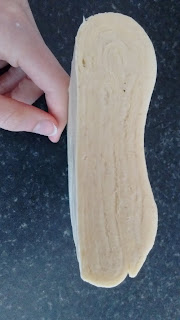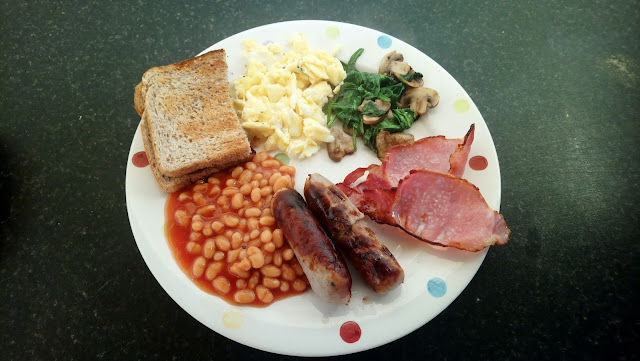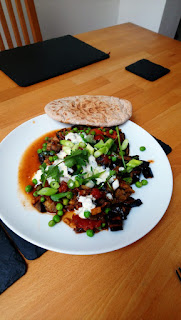Method:
1:Sift
the flour and salt into a large mixing bowl, then put the bowl in the
fridge for a few minutes to chill. (Keeping the flour and bowl cold will
help you to get a better result later and create nice layers of
pastry.)
2:Meanwhile, cut the butter into small cubes.
3:Using a round-bladed knife, stir the butter into the bowl until each piece is well coated with flour. {I use a cutlery knife. Also, I put the butter in a few blocks at a time so that I can coat them in flour just to try and avoid them sticking and clumping together as much.}
4:Pour in the water, then, working quickly, use the knife to
bring everything together to a rough dough.{The butter won't be mixed in
with the rest of it as you want streaks of butter running through your
pastry so don't try to squish them into the mixture}
5:Gather
the dough in the bowl using one hand, then turn it onto the work
surface. Squash the dough into a fat, flat sausage, without kneading.
Wrap in cling film then chill the dough in the fridge for 15 minutes.{You can go for longer if you wish, for my most recent pastry I left it in the fridge for 20-25mins}
6:Lightly
flour the work surface and the pastry. Roll out the pastry in one
direction until it’s about 1cm thick and three times as long as it is
wide, or about 45x15cm/18x6in. Straighten up the sides with your hands
now and again, and try to keep the top and bottom edges as square as
possible.
7:Fold
the bottom third of the pastry up, then the top third down, to make a
block about 15x15cm/6x6in. It doesn’t matter if the pastry isn’t exactly
the right size - the important thing is that the corners are nice and
square.
8:Turn
the dough so that its open edge is facing to the right, like a book.
Press the edges of the pastry together with the rolling pin.
9:Roll
out and fold the pastry again, repeating this four times in all to make
a smooth dough, with buttery streaks here and there. If the pastry
feels greasy at any point, or starts to spring back when as you roll,
then cover and chill it for 10 minutes before continuing.
10:Chill the finished pastry for an hour, or ideally overnight, before using. {When you use, I try to roll the dough in one direction for the beginning but then after that switch. I don't know why, I think it is just a weird habit}
11:When you use the pastry roll it out to about the thickness of a
£1 coin, and cook it at 200C/400F/Gas 6 for about 30 minutes. {This is only a guideline time, your recipe you are following may have different measurements e.g a palmier may take 20mins or a sausage roll 30mins, it just depends}
Butter:
What brand should I use?
Usually, I use the
Tesco Unsalted Butter 250g block and it works really well and gives good results, I haven't had a time when I've made puff with it and it hasn't worked...yet. Once, I used the
Lurpack 250g butter block and I found it went too soft too quickly for me, as I'm not the fastest pastry chef, and so I couldn't keep it as cold as it needed to be to form lamination lines and so my pastry didn't work. Lastly, I have tried it with
Co-Ops 250g butter block and it went really well, it was very similar results to the Tesco one and gave a good end result. So, in conclusion, if you are making puff pastry with Lurpack butter, maybe do it on a colder day or only if you are really quick and can work fast enough to prevent it from going greasy, otherwise, I would recommend either Tesco or Co-Ops own brands butter. However, this doesn't make a huge difference so don't fret it you can't get these particular brands.
Unsalted or salted?
Generally, it doesn't matter in terms of end result appearance, salted or unsalted, you shouldn't have a problem getting the flaky pastry you desire. But, for flavour reasons, typically unsalted butter is used as it provides a less-salty taste, you wouldn't want salty croissants would you? As well as this, unsalted butter allows you to control the amount salt in your baking which means you therefore have more control over the end flavour, you can always add an extra tsp of salt but you can't take it away. All in all, it's down to preference, if you want a salty pastry go ahead, use salted butter or unsalted with an extra tsp of salt added in so you can get it just right for you or use unsalted butter for a less salty pastry, it really is up to you.
Butter or marg?
For puff pastry, you really want to use a hard block of butter, not a spread. This is because you will need to cube the butter and coat it in flour and margarine would be too greasy to do this with. Also, the diced butter is needed to get streaks in the pastry with eventually help form lamination and flaky pastry that puff is used for. Additionally, when you are rolling out the dough the butter gets spread out whereas the marg would be already spread out and wouldn't give the right consistency for the dough.
Flour:
Can I use self-raising?
For puff, probably not, I did a bit of research and people generally were using self-raising flour in shortcrust, you can use plain as well, not puff. I think that the rising agent would interfere with the pastry when it was in the oven and cause it to uh...rise... which would give a different result to what you were looking for. On the other hand, you may want a puffier croissant so why shouldn't you use self-raising flour? Well, the answer is, I don't know! Personally, I wouldn't recommend it but if you want to give it a go let me know but I am not 100% sure how well it would turn out.
Can I use wholemeal flour?
Yes, but you will get a more robust flavour and I would suggest that you mix it half and half with plain flour, just because wholemeal tends to give a tougher end result pastry, which most people aren't accustomed to. I found a recipe that uses wholewheat bread flour and they said on their blog (
Here) that they wouldn't substitute for wholewheat pastry flour '
The whole wheat bread flour here gives the dough a nutty flavour
without interfering with the lightness of the layers. I would not
substitute whole wheat pastry flour, as it might not contain enough
gluten to create strong layers of dough. Lacking a food processor, you
can probably make this by rubbing in the butter with your fingers or a
pastry blender. Bear in mind that the butter doesn’t get incorporated as
much as in a pie dough.' This seems to say that if you want to use wholewheat flour use a bread flour rather than a pastry flour but I don't think it would make a huge difference.
What flour do you use?
I usually use
Tesco plain flour, as Tesco is our local supermarket, but if we don't have any in I will just use what we have in the cupboard at the time.



Comments
Post a Comment